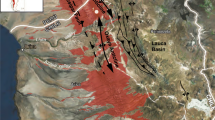Summary
Evidence for flow structure within hexagonal columns of basalt has been sought, using measurements of the anisotropy of magnetic susceptibility. The observed magnetic grain alignment indicates that the flow was essentially uniform and horizontal across the hexagons which were sampled. The flow probably occurred during emplacement of the lava; there is no evidence of convection within the hexagons, either from the degree of grain alignment or its orientation.
Similar content being viewed by others
References
J. W. Graham,Magnetic susceptibility anisotropy, an unexploited petrofabric element, Bull. Geol. Soc. America65 (1954), 1257.
J. R. Balsiey andA. F. Buddington,Magnetic susceptibility and fabric of some Adirondack granites and orthogneisses, Am. J. Sci.258 A (1960), 6.
F. D. Stacey,Magnetic anisotropy of igneous rocks, J. Geophys. Res.65 (1960), 2492.
F. D. Stacey, Germaine Joplin andJ. Lindsay,Magnetic anisotropy and fabric of some foliated rocks from S. E. Australia, Geofis. pura e appl.47 (1960), 30.
M. A. Khan,The anisotropy of magnetic susceptibility of some igneous and metamorphic rocks, J. Geophys. Res.67 (1962), 2873.
S. Uyeda, M. D. Fuller, J. C. Belshè andR. W. Girdler,Anisotropy of magnetic susceptibility of rocks and minerals, J. Geophys. Res.68 (1963), 279.
D. B. Stone,Anisotropic magnetic susceptibility measurements on a phonolite and a folded metamorphic rock, Geophys. J., Roy. Astr. Soc.7 (1963), 375.
S. I. Tomkieff,The basalt lavas of the Giant's Causeway district of Northern Ireland, Bull. Vulcan. Napoli6, 2 (1940), 89.
A. Spry,The origin of columnar jointing, particularly in basalt flows, J. Geol. Soc. Australia8 (1962), 191.
D. Lefeber,Columnar jointing and intracolumnar differentiation in basaltic rocks, Brouer. Mem. Vol., Roy. Netherlands Geol. Soc. (1956).
E. Irving andL. G. Parry,The magnetism of some Permian rocks from New South Wales, Geophys. J., Roy. Astr. Soc.7 (1963), 395.
F. D. Stacey,Magnetic anisotropy of dispersed powders, Aust. J. Phys.13 (1960), 196.
R. F. King andA. I. Rees,The measurement of the anisotropy of magnetic susceptibility by the torque method, J. Geophys. Res.67 (1962), 1565.
Author information
Authors and Affiliations
Rights and permissions
About this article
Cite this article
Brown, H.C., Khan, M.A. & Stacey, F.D. A search for flow structure in columnar basalt using magnetic anisotropy measurements. PAGEOPH 57, 61–65 (1964). https://doi.org/10.1007/BF00879709
Received:
Issue Date:
DOI: https://doi.org/10.1007/BF00879709




